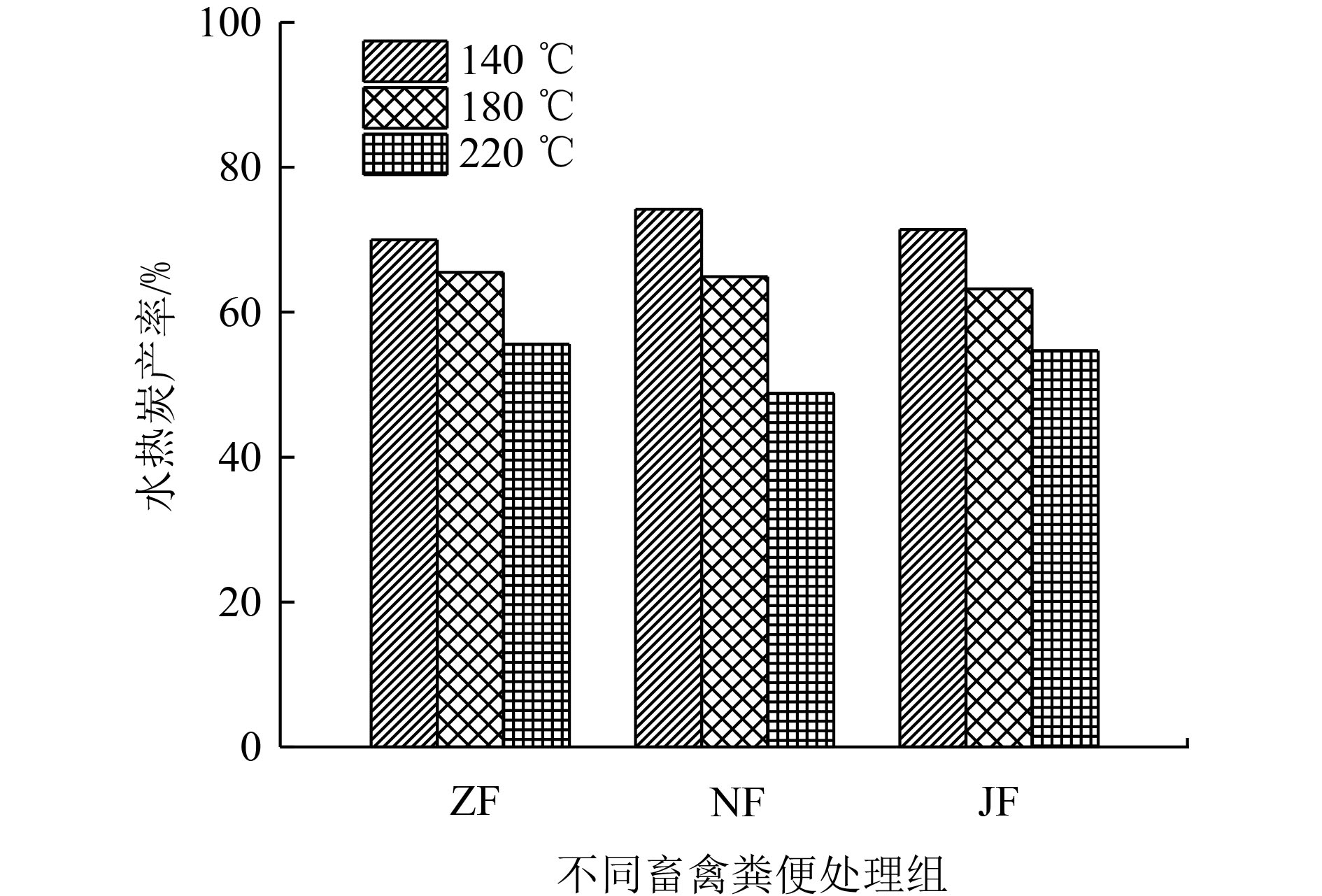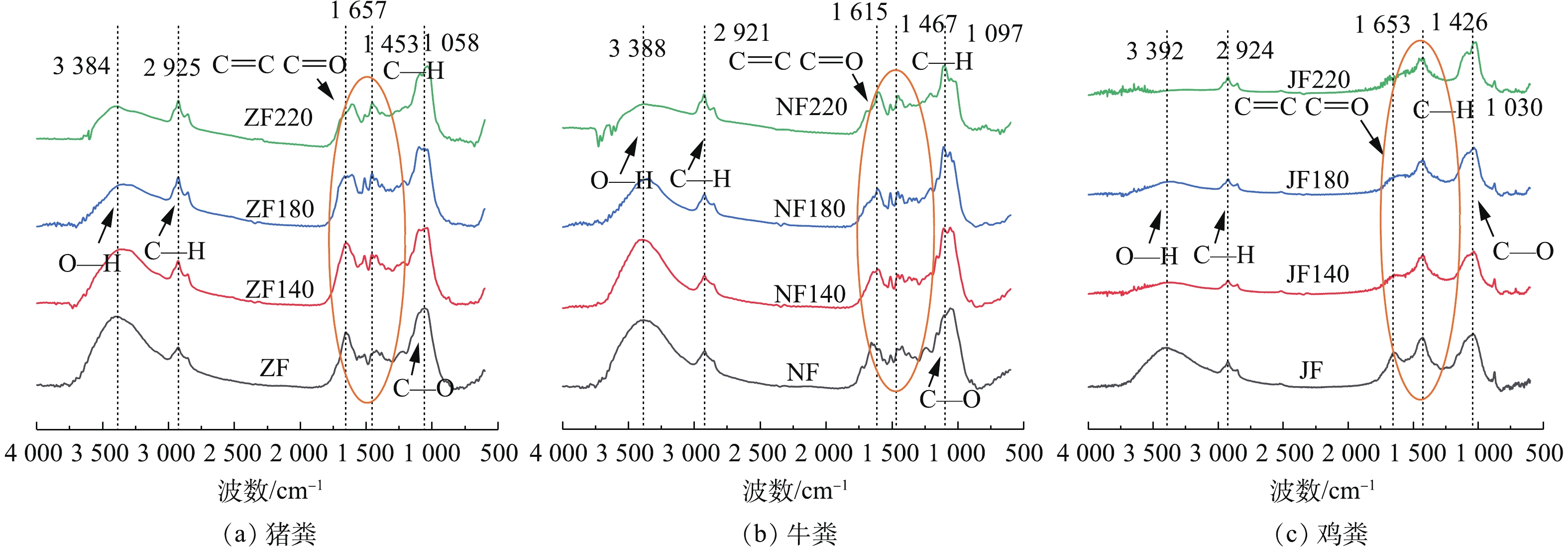-
中国是畜禽养殖大国,每年畜禽粪污产生量约3.8×109 t,但其综合利用率却不足60%[1]。为了加快推进畜禽养殖废弃物处理和资源化,2017年,国务院办公厅印发了《关于加快推进畜禽养殖废弃物资源化利用的意见》[2]。该文件明确指出,到2020年,全国畜禽粪污综合利用率要达到75%以上。采用何种途径来提高畜禽粪污综合利用率已经成为亟需解决的问题。
近年来,水热炭化(hydrothermal carbonization,HTC)技术在固体废弃物处理方面表现出多种优势,已引起研究者们的广泛关注[3-5]。水热炭化是指在一定的温度、反应时间和压力条件下,有机物料经过水热反应分解并转化为水热炭[6-7]。与传统的干法(热裂解)相比,水热炭化具有物料含水率选择性高、工艺操作简单、能耗低、反应条件温和以及水热炭产量大、养分保留量高且官能团丰富等优点,被认为是用来处理高含水率有机废物的一种非常有应用前景的技术[8-10]。
目前,水热炭化法已被广泛应用于处理高含水率的有机废弃物,特别是用来处理污泥和餐余垃圾[11-13]。对于畜禽粪便,水热炭化技术也可实现将其快速处理转化为水热炭的目的。然而,有关温度对畜禽粪便水热炭特性的影响研究[14-15]还较少,特别是温度对水热炭中碳的形态及保留量的影响。为此,本研究在实验室条件下,利用水热炭化技术考察了温度对畜禽粪便水热炭的产量及其特性的影响,以期为畜禽粪便的水热炭化处理提供参考。
全文HTML
-
牛粪、猪粪和鸡粪分别取自安徽省凤阳县某养牛场、某养猪场和某养鸡场。分别取畜禽粪便风干样品25 g(烘干基),按固液比1∶12(质量比)添加蒸馏水,置于500 mL的不锈钢高压反应釜内,混合均匀后,密闭反应釜。将密闭反应釜放入恒温烘箱内进行加热,待温度升至设定温度(140、180和220 ℃)后,维持恒温20 h,关闭电源,待温度降至室温后,取出反应釜。利用真空抽滤的方法,实现反应釜内混合液的固液分离,固体产物即为水热炭。水热炭在干燥箱中80 ℃恒温烘干至恒重。牛粪、猪粪和鸡粪水热炭分别记为NF140-NF220,ZF140-ZF220和JF140-JF220(字母代表畜禽粪便种类,数字代表水热温度)。
-
畜禽粪便水热炭的产率采用质量差法进行测定;畜禽粪便水热炭的C、H和N含量使用Vario EL Ⅲ元素分析仪测定,采用差减法计算O元素的含量[16];畜禽粪便水热炭经硝酸-高氯酸消化后,消化液用iCAP-7200电感耦合等离子体发射光谱仪测定Pb、Cu、Zn、Cr和Cd含量。畜禽粪便水热炭与溴化钾(光谱纯)按质量比1∶200研磨均匀后压片,再置于傅里叶交换红外光谱仪(赛默飞 Nicolet is10)中,于400~4 000 cm−1波段内扫描。
-
水热炭的产率(Y)计算方法如式(1)所示。
式中:Y为水热炭的产率;m1为粪便生物质质量,g;m2为粪便水热炭质量,g。
水热炭的碳保留量(S)计算方法如式(2)所示。
式中:S为水热炭的碳保留量;C1为粪便水热炭含碳量;C2为粪便生物质含碳量。
重金属元素相对富集系数R计算方法如式(3)所示。
式中:R为重金属元素相对富集系数;H1为粪便水热炭重金属元素质量分数,mg·kg−1;H2为粪便生物质重金属元素质量分数,mg·kg−1。
1.1. 畜禽粪便水热炭的制备
1.2. 分析方法
1.3. 数据处理
-
图1为不同温度下畜禽粪便水热炭的产率。由图1可知,猪粪、牛粪和鸡粪水热炭的产率分别从140 ℃的70.0%、74.2%和71.4%降到220 ℃的55.6%、48.8%和54.7%。随着水热炭化温度的升高,畜禽粪便水热炭产率逐渐降低,这可能是由于高温利于畜禽粪便水热分解。此外,不同畜禽粪便水热炭产率的差异,可能是由于水热炭化通过影响其炭化组分(挥发分、固定碳和灰分)的产率进而影响水热炭的产率[17]。
-
畜禽粪便及其水热炭的元素分析结果如表1所示。由表1可知,畜禽粪便N含量高低顺序依次为猪粪>鸡粪>牛粪,C和H含量高低顺序依次为牛粪>猪粪>鸡粪,O含量高低顺序依次为猪粪>牛粪>鸡粪。由此可见,不同畜禽粪便水热炭元素组成,随温度变化的规律不一致。随着水热炭化温度的升高,猪粪水热炭和牛粪水热炭的N和O含量逐渐降低,C含量逐渐增加,H含量先增加后降低;而鸡粪水热炭的N和C含量先降低后增加,O含量先增加后降低,H含量逐渐降低。
H/C被广泛用来评价水热炭的芳香性及稳定性[18-19]。在本研究中,畜禽粪便水热炭的H/C值均低于其粪便的H/C值,且随着水热炭化温度的升高而逐渐降低。由此可见,禽粪便经水热炭化后其芳香性及稳定性增强,且随着温度的升高,畜禽粪便水热炭的芳香性及稳定性增强,这和已有研究结果[14, 20]一致。(O+N)/C通常被用来表征物质的极性[21-22]。随着温度的升高,猪粪和牛粪水热炭的(O+N)/C降低,表明其极性随着温度升高而降低;而鸡粪水热炭的(O+N)/C则是先增加后降低。O/C的变化规律基本与(O+N)/C的变化一致。较高的O/C是由于水热炭表面某些官能团发生氧化导致含氧官能团数量增加。随着水热炭化温度增高,猪粪和牛粪水热炭的O/C逐渐降低。
综上可知,畜禽粪便经过水热炭化后,平均超过50%的碳被保留在水热炭中,变化范围为49.6%~82.1%。随着水热炭化温度的升高,猪粪水热炭的碳保留量先增加后减少,且变化幅度不大,而牛粪和鸡粪水热炭的碳保留量则逐渐减少。与NF140和JF140相比,NF220和JF220的碳保留量分别减少了22.8%和30.1%。由此可见,低温利于畜禽粪便水热炭中碳的保留。此外,相同温度下,畜禽粪便水热炭的碳保留量大小顺序依次为猪粪>牛粪>鸡粪。
-
图2为畜禽粪便及其水热炭的红外谱图。从图2可以看出,3 384 cm−1左右处为醇、酮、酯和苯酚的O—H伸缩振动。随着水热炭化温度的升高,该峰逐渐减弱,鸡粪在220 ℃时已趋于0,说明随着水热炭化温度升高,羟基逐渐被完全降解,这和王定美等[20]发现在不同水热炭化温度下污泥水热炭的红外谱图的变化规律相似。2 925 cm−1和1 453 cm−1左右处为脂肪基团C—H的拉伸和弯曲振动吸收峰,可以看出,猪粪和牛粪中脂肪族物质含量高于鸡粪。随着水热炭化温度的升高,猪粪和牛粪水热炭的C—H吸收峰逐渐增强,鸡粪表现为先减弱后增强的趋势。1 657 cm−1左右为芳香类化合物中C=C伸缩振动吸收峰,随着水热炭化温度的增高,猪粪水热炭在该峰处吸收强度逐渐增强,牛粪水热炭为先增强后减弱,鸡粪水热炭则逐渐增强。随着温度的升高,畜禽粪便中所含的多糖和碳水化合物等脂肪族化合物降低,进而形成相对稳定的芳香结构。1 030~1 097 cm−1为C—O吸收峰,磷酸盐中P—O伸缩振动或Si—O—Si反对称伸缩振动,畜禽粪便原料经水热处理后均比原料增强,但不同水热炭化温度下畜禽粪便水热炭在该处吸收峰强度差别不大。
-
畜禽粪便及其水热炭中重金属元素的含量及其相对富集系数如表2所示。由表2可知,猪粪中所有重金属含量均高于牛粪和鸡粪,特别是Cd的含量。此外,随着水热炭化温度的升高,畜禽粪便水热炭中各重金属含量的变化规律不一致。水热炭化温度越高,猪粪水热炭的Cu、Zn和Cd的含量逐渐增加,相对于猪粪分别增加了33.4%~55.2%、35.3%~60.6%和35.4%~55.9%;Pb的含量则先降低后增加,但都小于猪粪Pb的含量,相对于猪粪降低了16.4%~47.4%;Cr的含量逐渐降低,但都高于猪粪Cr的含量,相对于猪粪增加了45.1%~76.2%。水热炭化温度越高,牛粪水热炭的Cu、Zn和Cr的含量逐渐增加,相对于牛粪分别增加了31.2%~117%、12.3%~99.2%和18.6%~71.9%;Pb的含量逐渐降低,但都高于牛粪Pb的含量,相对于牛粪增加了3.5%~87.9%;Cd的含量先降低后增加,数值变化不大,但都低于牛粪Cd的含量,相对于牛粪减少了17.8%~22.2%。水热炭化温度升高,鸡粪水热炭的Cu、Zn和Cr的含量先增加后降低,数值变化不明显,但都高于其鸡粪中含量,相对于鸡粪增加了21.6%~23.9%、39.2%~40.4%和−0.5%~9.7%;Pb的含量先降低后增加,相对于鸡粪增加了−2.3%~0.5%;Cd的含量先降低后增加,相对于鸡粪增加了−28.6%~53.6%。
畜禽粪便及其制备的水热炭中重金属含量的高低是其综合利用的限制因子,而畜禽粪便水热炭中重金属含量与炭化过程、金属元素的特性等因素有关。王煌平等[17]研究表明,与畜禽粪便原材料中重金属含量相比,热解过程均不同程度地提高了水热炭中重金属元素的含量,且随着热解温度的升高而增加(少数情况除外),这与本研究的结论相似。JIN等[23]研究表明,热解升温可增加污泥水热炭重金属元素含量。王定美等[20]研究表明,污泥水热炭化后,水热炭中重金属含量均有不同程度的增加,并随着炭化温度升高,变化规律不一致;并进一步指出,水热炭中重金属含量与元素本身的性质有关,这和本研究的结论一致。
目前,国际上尚无水热炭重金属含量限定标准,畜禽粪便水热炭作为一种外源物料施用农田,也没有相关标准。本研究参考的是现有的有机肥料标准和土壤环境质量标准中重金属的限值(表3)。从重金属类型看,畜禽粪便及其水热炭中重金属Pb和Cr含量都没有超出有机肥料标准和土壤环境质量标准;Zn含量全部超出有机肥料标准和土壤环境质量标准;猪粪及其水热炭Cu含量均超出有机肥料标准和土壤环境质量标准;而牛粪和鸡粪的Cu含量仅超出土壤环境质量标准。猪粪及其水热炭的Cd含量全部超出有机肥料标准和土壤环境质量标准,且超标严重;牛粪及其水热炭的Cd含量没有超出有机肥料标准,但超出土壤0.3 mg·kg-1的标准;而鸡粪及其水热炭的Cd含量均没有超出标准。综上所述,畜禽粪便水热炭在资源化利用上仍存在着一定的潜在环境风险,特别是猪粪及其水热炭在应用前必须进行严格管控,这和以往研究的结论一致[17, 24-25]。
各种金属元素的相对富集系数(表2)显示,除猪粪中Cr在140 ℃及牛粪中Cu在180 ℃和220 ℃的相对富集系数(R)>1外,其他畜禽粪便水热炭重金属元素的R值均≤1。在同一温度下,牛粪水热炭中Cu的R值均大于其他重金属;同一重金属Pb,猪粪水热炭的R值均小于其他粪便水热炭。随着水热炭化温度的升高,各金属元素的R值变化规律取决于畜禽粪便的种类和重金属的类型。R值>1时,该元素表现为富集性,R值<1时则为迁移性[26]。本实验中绝大多数的水热炭的重金属元素的R值都<1,表现为迁移性。这也说明了畜禽粪便在水热炭化过程中,部分重金属被保留固定在水热炭中,其稳定性及形态变化有待做进一步研究;还有部分重金属从畜禽粪便固相中进入到热解液态产物中,这也为畜禽粪便中重金属的处理与处置,开辟了新途径。此外,热解液也面临着重金属处置的问题,有待作进一步研究。
2.1. 畜禽粪便水热炭的产率
2.2. 元素组成及碳保留量
2.3. FT-IR分析
2.4. 重金属含量及富集系数
-
1)畜禽粪便水热炭产率为48.8%~74.2%。温度升高时,水热炭的产率和H/C均随之降低,但其芳香性及稳定性均增强。畜禽粪便中49.6%~82.1%的碳被保留在水热炭中,相同温度下,水热炭的碳保留量变化趋势为猪粪>牛粪>鸡粪。
2)随着水热炭化温度的升高,畜禽粪便水热炭羟基逐渐减弱,其他官能团变化规律与畜禽粪便种类有关。
3)畜禽粪便经水热炭化后其重金属含量均增加。随着温度的升高,各金属元素的相对富集系数变化规律取决于畜禽粪便的种类和重金属的类型。水热炭化为畜禽粪便综合利用开辟新途径,但在资源化利用上也存在潜在环境风险,特别是猪粪及其水热炭在应用前必须进行严格管控。
4)温度会极大地影响畜禽粪便水热炭的性能。综合考虑水热炭产率、碳保留量、稳定性及重金属富集情况,建议水热炭化温度确定为180 ℃。






 下载:
下载:

 百度学术
百度学术


